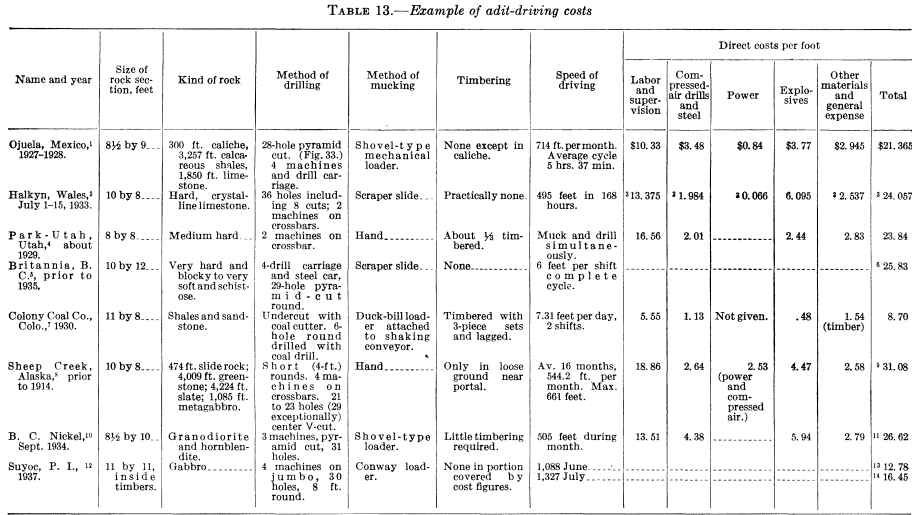Table of Contents
Although practices in vogue for many years are still employed in small-scale operations, decided advances have been made, particularly in the last decade and especially in connection with large-scale operations. Contributing to this are introduction of mechanical loading equipment, mechanical ventilation, availability of cheap power, improved rock-drilling equipment, use of drill carriages and tenders in large headings, and mechanical haulage, all of which help to increase speed. The use of mechanical loading equipment permits pulling longer rounds at the same or lower total cost per foot.
Mechanization has not been brought about solely as the result of a desire to lower costs or to increase speed but, to an extent greater than is sometimes appreciated, by changing labor conditions. The younger generation of miners is more averse to arduous handwork than the older ones but takes kindly to operating machines.
Mining Equipment
Equipment for driving is of four general types—drilling, blasting, loading and transportation, and ventilating.
Modern drilling equipment comprises rock drills; rock-drill accessories, including drill mountings, hose, and fittings; drill-steel and drill-sharpening equipment; air-compressor and motive power; and pipe lines for air and water. On some large jobs, mobile drill carriages and tenders also are included. Among the more recent innovations that are increasing in favor are detachable drill bits. When these are employed, a bit-grinder also may be required. The type and size of rock drill employed will depend on the nature of the ground. Where the rock is hard, 3-, 3½-, or 4-inch Leyner-type drifters are customary. In the softer ground, mounted jackhammer-type drills of about 2 5/8-inch bore may be used. Quite recently automatic-feed drifters have been introduced and are finding favor on some jobs. Wet-drilling is or should be used in all adit work.
In large or moderately large headings and for use in fast driving, drill carriages have often proved advantageous. On these carriages are mounted the drill columns and arms, air and water manifolds with large hose for connection to the pipe lines, and regulation hose for connection to the machines. Racks for drill steel may also be included or may be carried on a separate truck or tender. Figure 22, A, shows a drill carriage and figure 22, B, a tender employed in driving an adit at Ojuela, Durango, Mexico.
It will be noted that in this outfit only the drill bars are mounted on the carriage and the compressed-air connections are on the tender, which also carries a Coppus blower for ventilation.
Blasting may be done either with fuse and caps or electric detonators. Electrical firing has the advantages of safety and reduction in amount of smoke produced, and with delay detonators the proper sequence of firing and hence a better break is assured. Electric firing may be done from a power circuit or by use of blasting machines. When a power circuit is employed, the necessary switches must, of course, be provided. If the power circuit is a high-voltage one, step-down transformers also are necessary.
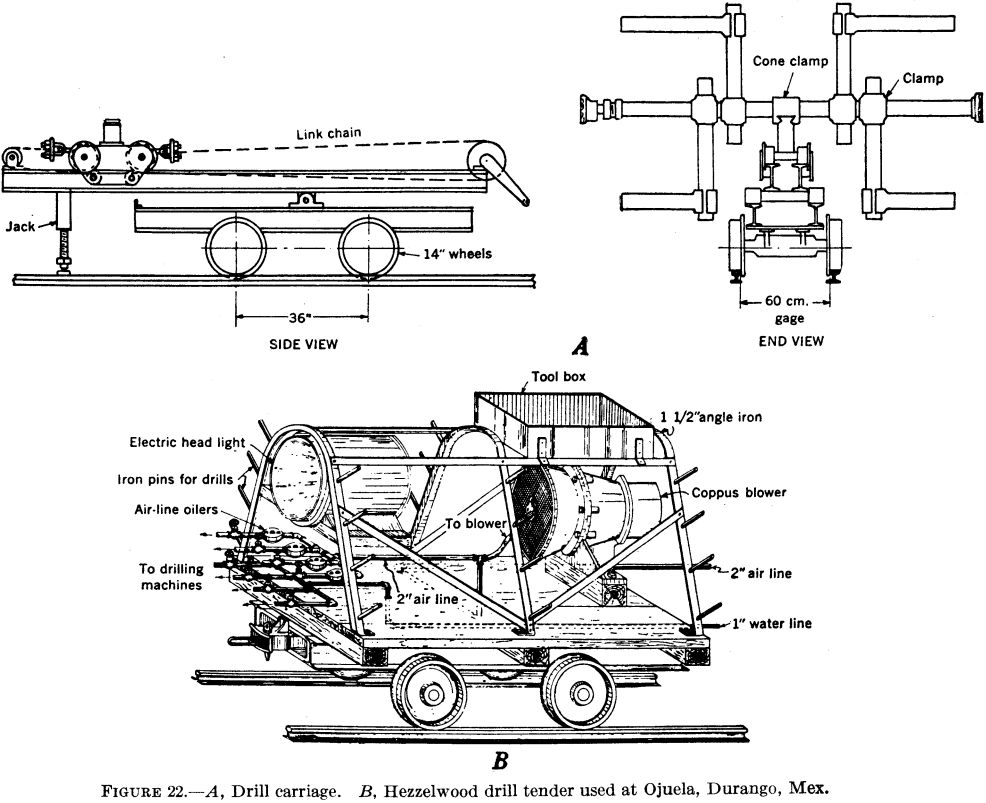
When loading is by hand, picks, shovels, and sledges for breaking boulders are about all that is required. Mechanical loaders are of two general types—scrapers and shovel or dipper-type machines.
Mechanical Loaders
Scrapers
Scraper-loading has been discussed in an earlier Bureau of Mines publication. For use in driving headings, a scraper-loader consists of the following essential elements: A hoist, preferably double-drum, driven by electric motor or compressed air and mounted on a scraper slide or ramp; a scraper of the hoe, semi-hoe, or box type; pull and tail ropes; tail-rope sheave and means of anchoring it at the face; and a scraper slide mounted on wheels and terminating at the rear end in a boom, under which the rock cars are spotted for loading. The slide may, if desired, be mounted on caterpillars. Cars may be spotted and changed by hand, locomotive, or a car-puller.
Figure 23, A, shows a common type of scraper slide with the hoist mounted above it and a car spotted in loading position under the boom, and figure 23, B, is one with the hoist mounted below the slide. Figure 24 shows an outfit in which the slide and boom are mounted on a large car and the hoist on a tender at the rear. This equipment is adapted to straight headings having a cross section of 8 by 10 feet or larger; delays in loading occasioned by frequently changing cars, which are unavoidable with small cars, may be reduced to a minimum by the use of large cars. Figure 25 shows several types of scrapers used with loading slides.
Among the advantages of scraper loaders is their comparatively small first cost and low maintenance charges. Power costs are low, especially if electric drive is employed; primary power consumption with electric drive is only about one-eighth that with compressed-air drive. The largest single item of operating expense next to labor is renewal of wire ropes. Another advantage lies in the fact that only the scraper, a relatively inexpensive part of the equipment, need go near the face, which is an advantage in some ground where the back may fall. The hoist, scraper, and ropes can often be used interchangeably between development headings and stopes, thus reducing the total investment in loading equipment.
Although scrapers sometimes are used in small headings, ordinarily they will not save much as compared to hand loading in headings less than about 7 by 7 or 8 by 8 feet in cross section. For headings smaller than this, a small shovel-type loader is often preferable. For headings of this size and larger, scraper loading usually can show a saving in cost per foot and greater driving speed as compared to hand loading. By properly proportioning the size of the scraper and the capacity of the hoist to the size of the heading, scraper loading can be employed successfully in any size of heading above the minimum. If the proportion is right and proper facilities are provided for handling cars and eliminating delays, about 2 hours will be required to muck out a heading, regardless of its size.
With any type of mechanical loading, efficient operation depends on elimination of delays, which add to the time the machine must remain at the face and reduce the ratio of actual loading time to total time. This is particularly important in speed work, where each cycle (drilling, blasting, mucking) follows the preceding one in quick succession.
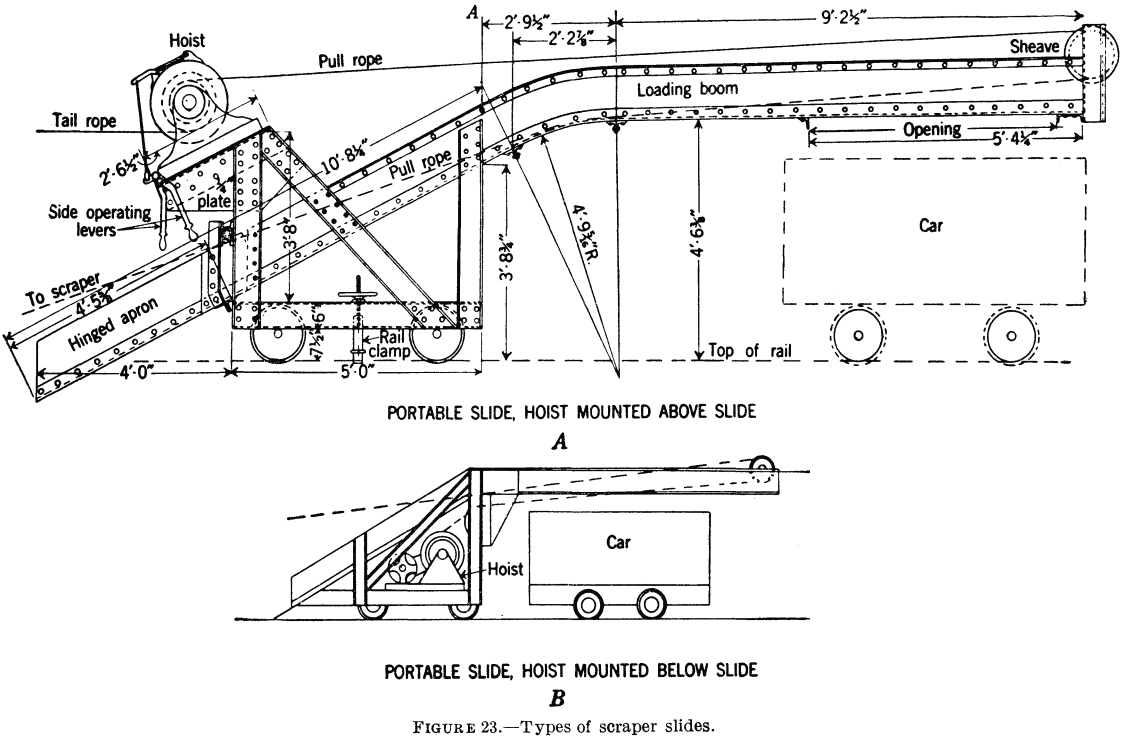
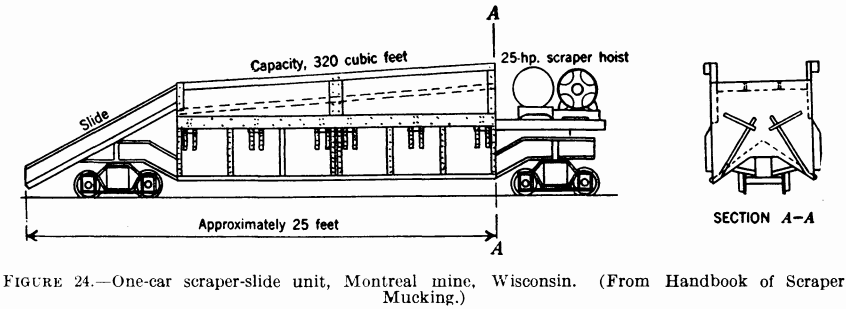
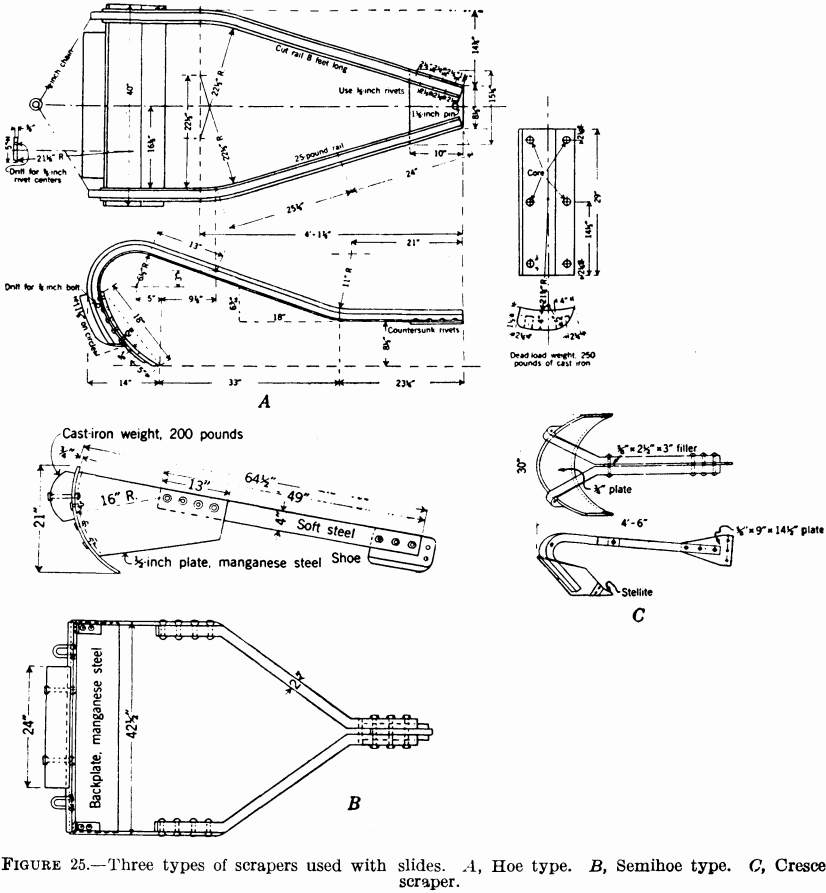
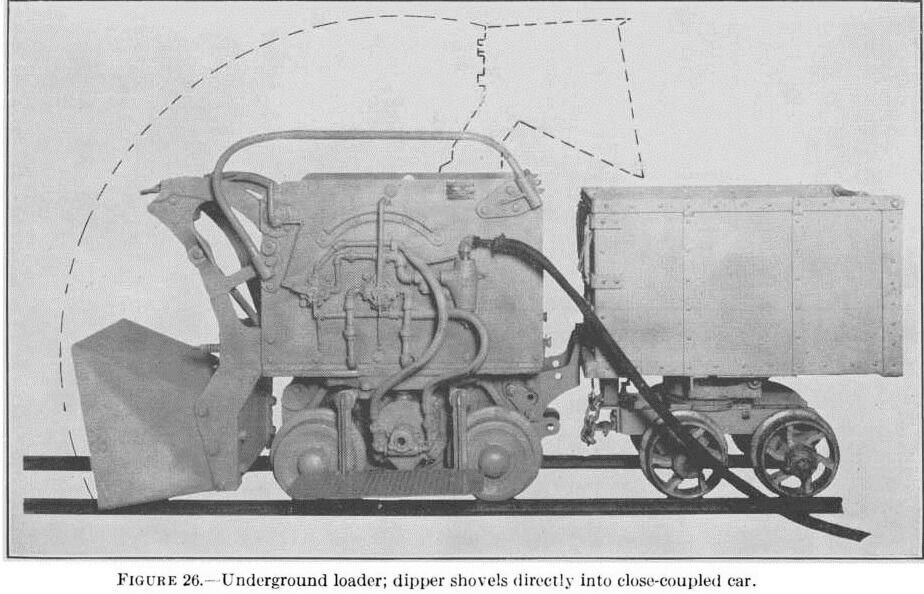
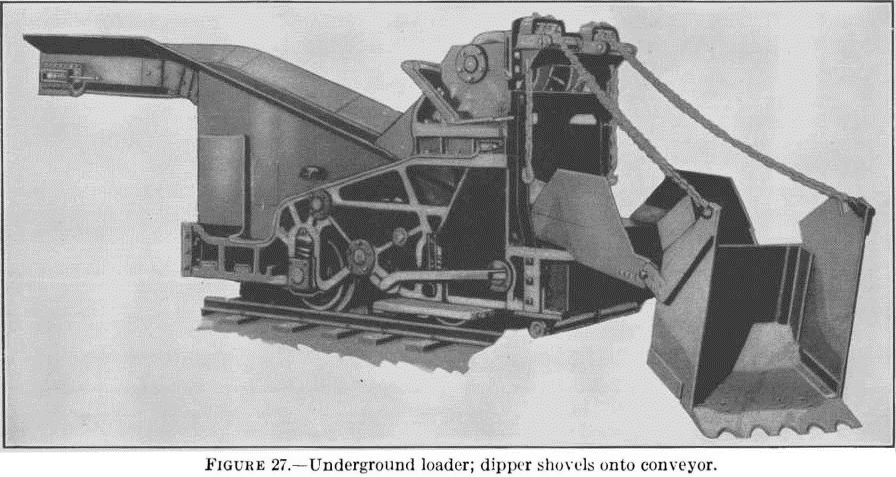
Shovel loaders
Shovel loaders employed in metal-mine work are of two general types—those that load directly into a car close-coupled behind the loader (fig. 26), and those that load onto a conveyor belt that delivers the rock to the car (fig. 27). They are generally driven by compressed air. The first type is most common in mine work and is particularly well adapted to headings smaller than 7 by 7 or 8 by 8 feet in cross section. Scraper loaders are competitors in larger headings, and the choice depends on local conditions or personal preference. The second type of shovel loader also competes with scrapers in larger headings but is generally not applicable to small headings. This and previous generalizations are based on personal observations of current practice and equipment, and it is realized that as they are written or before they are published new machines may be on the market that might necessitate modification of the statements made.
Shovel loaders commonly are mounted on wheels (fig. 27) and run on the mine track, and in types now most commonly employed the dipper is thrust into the muck pile by the tractive power of the machine. These loaders may be moved in and out of the heading under their own power or may be hauled by a mine locomotive. Scraper loaders usually must be hauled. Shovel loaders are also sometimes mounted on caterpillar crawlers (fig. 28). Another type of shovel loader is similar to shovels employed on surface, the thrust being transmitted to the dipper through a dipper stick or other thrust mechanism, which, when raised, may be swung to deliver the rock to one side of or behind the machine.
As this is written, a paper is in course of preparation on Shoveling Machines in Underground Metal Mines, to which the reader is referred for greater detail. This paper is based upon a study, extending over a year, of the use of shovel-type loaders in metal mines in a large number of districts in the Eastern, Central, and Western States.
Transportation equipment
After the rock is loaded into cars by hand or mechanically, it usually is trammed to the dump in cars by hand or by a locomotive. Hand tramming is not, as a rule, economical for long distances. When the cars are loaded mechanically they are sometimes trammed a short distance by hand to a siding and from there hauled by locomotive. Small cars of 1 or 2 tons capacity are employed for hand tramming and cars of 1 to 6 tons or greater capacity when motor haulage is employed.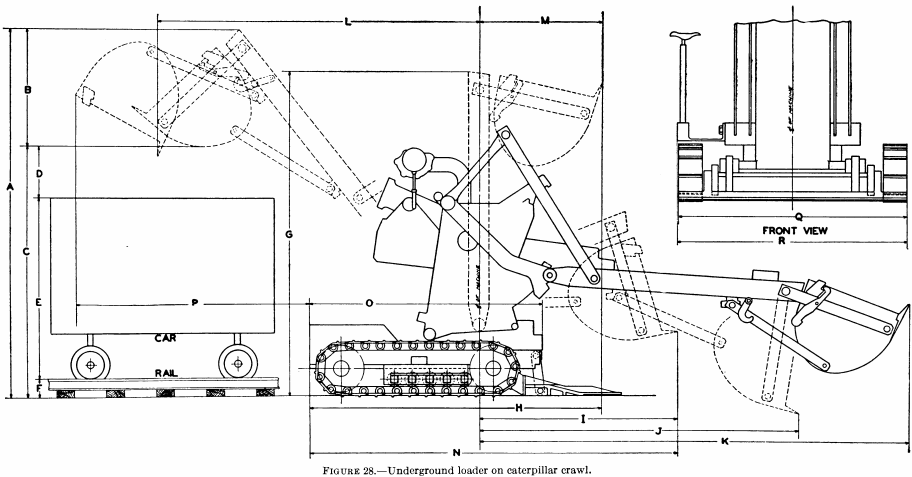
Large cars are preferred for mechanical loading, as they enable the loader to work more continuously.  The one-car scraper-slide unit shown in figure 24 has already been mentioned. With this equipment, the entire unit is hauled to the dump when the car has been filled and loading is interrupted until it has been returned to the face. When ordinary cars are employed, the time occupied in switching is not necessarily all lost, as frequently the shovel (or scraper) can be employed in cleaning up, preparing the muck pile for loading, or in moving ahead.
The one-car scraper-slide unit shown in figure 24 has already been mentioned. With this equipment, the entire unit is hauled to the dump when the car has been filled and loading is interrupted until it has been returned to the face. When ordinary cars are employed, the time occupied in switching is not necessarily all lost, as frequently the shovel (or scraper) can be employed in cleaning up, preparing the muck pile for loading, or in moving ahead.
Cars ordinarily are steel and of the types commonly employed in metal mines. They usually have roller bearings and may dump endwise or sidewise by tipping the body, or they may be of the bottom-discharge or gable-bottom type. The manner of dumping depends on facilities and conditions on the dump or may be determined by the type of car most readily available. Either trolley or storage-battery locomotives are suitable for haulage in adits and tunnels. Gasoline-driven locomotives should not be employed because of the danger from exhaust fumes.
Track is ordinary steel rail of proper weight for the service to which it is put or is to be put later and is laid on the adit grade. For locomotive haulage one-fourth to one-half percent upgrade to the face has been found most satisfactory. If the principal function of the adit is for drainage rather than haulage, steeper grades may be preferable.
To permit running cars and shovel loaders close to the face, short sections of track can be made up with fish plates for connection to the end of the permanent track. For quick change of cars behind a mechanical loader, movable switches and turnouts are convenient. Figure 29 shows the arrangement used in driving at Ojuela. An arrangement for lifting the car off the track and to one side has been employed satisfactorily to pass cars on a single track. In headings wide enough for double track, passing arrangements readily can be provided.
Rubber-tired trucks without track have been employed for transporting broken rock, and it is likely that in the future loading onto belt or pan conveyors extending from the face to the dump may come into quite common use in tunnel driving.
Ventilating equipment
Ventilation of the face is important, particularly in long adits and high-speed driving. If natural ventilation only is employed, the time interval that must be allowed between blasting and return to the face for mucking becomes increasingly longer as the length of the adit increases, which obviously reduces the speed that otherwise might be attained. It has long been customary to turn on the compressed-air line and blow out the face after blasting and to depend to some extent, at least, on the exhaust from rock drills or loading machines to provide ventilation while men are working at the face.
Although this may be fairly satisfactory in short headings, it is an expensive method from the standpoint of power consumption in any case, and in long headings is not as satisfactory as an independent low-pressure ventilation system.
The most positive and efficient system is an independent low-pressure one with a reversible fan at the entrance delivering air to the face through a steel pipe. Collapsible tubing in place of the steel pipe is widely used when it is desired only to blow air to the face and is very handy for this purpose as an extension from the end of the pipe that is usually kept some distance back from the face to prevent damage from blasting. Thus, while drilling or mucking, the tubing can be attached to carry air right to the face, and just before blasting it can be rolled back out of the way.
In some instances return to the face after blasting can be expedited by exhausting through the pipe for a period and then blowing by reversing the fan. There is some difference of opinion about this, but if the pipe can be kept near enough to the face the fumes may be exhausted quickly while the workmen are entering, through fresh air drawn in to displace that exhausted through the pipe; whereas in blowing, some of the fumes simply will be churned about at the face for some time while the rest are being blown out the adit, and the men entering must pass through them at some place along the heading. Obviously, collapsible tubing cannot be used for exhausting.
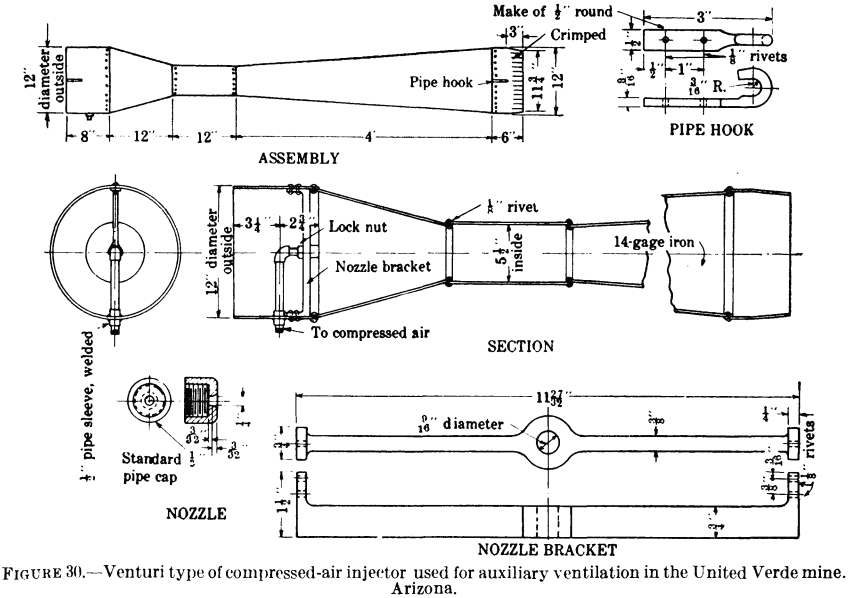
Ventilators of the injector type have been employed to a considerable extent. They are cheaply constructed and easily installed but waste so much power that they are used only in temporary or emergency auxiliary service 80 (such as in driving adits or tunnels). Air jets and injectors take many forms, from nozzles designed to screw onto a compressed-air hose to well-designed venturi types (fig. 30). The nozzle is connected to the compressed-air line, as shown in the illustration. The efficiency of even the best venturi types is usually less than 7 percent for the jet and 45 percent for production of compressed air, or 3 percent over-all.
Methods of Driving Adit
It is not proposed to begin a long discussion of practices employed in driving mine headings that have been described in detail in an earlier Bureau of Mines publication. Methods employed in driving adits are virtually the same as those used in drifts and crosscuts, numerous descriptions of which are given in the series of information circulars on mining methods and costs published by the Bureau beginning in 1929 and continuing to the present.
In driving large aqueducts, railroad and vehicular tunnels, and the like, special technique often is employed, such as carrying a low heading at the top ahead of the bottom bench, which is taken up later, or driving a small pilot tunnel that is later enlarged to finished size. In mine work, the face usually is advanced as a single full-size heading, though modifications of this may be employed where unusual conditions, such as running, swelling, or sloughing ground, occur. Thus, it may be necessary to keep timber close to the face and spile ahead, or to drive a narrow vertical slot on both sides and over the top of the face, put in posts, cap, and lagging, and then remove the core.
Generally, adits may be advanced by drilling and blasting regular rounds, which often can be standardized for the particular conditions of each job. The principle upon which standard types of rounds are based is to drill cut-holes, which when blasted pull out a small plug or wedge of rock, providing free faces to which surrounding holes, timed to go slightly later, will break. In ground at all tight it is axiomatic that if the cut-holes fail to break out the cut the other holes will fail to break well unless unusual slips or seams happen to cause a freak break.
The principal types of rounds are those employing a V or wedge-shaped cut; a “pyramid” cut that pulls a pyramid or cone-shaped block near the center of the face; a “Michigan” or “burnt” cut that pulls a cylindrical core near the center of the face; and the “swing” or “slabbing” cut. By whatever names these cuts may be called locally, they are of these types or merely variations thereof. The V cut may be drilled to pull a horizontal wedge extending across the face from side to side or a vertical one from top to bottom. Such a wedge is usually across or up and down near the center line of the face but may be above, below, or to one side. Sometimes the wedge is along one rib or along the bottom, when it may be termed a “draw” cut or, in the latter case, a “toe” cut.
In the V cut two rows of holes are drilled at angles to the face such that opposite holes meet at the bottom or nearly so (fig. 31, A). In the pyramid cut the holes are drilled at angles to meet, or nearly so, at a common point to permit concentration of the explosive charge as much as possible at the bottom of the cut (fig. 31, B). In this cut there may be 3 to 8 (usually 4) holes all drilled toward a common point. In the burnt cut a number of holes are drilled straight in (normal to the face), as in figure 31, C. In the round depicted, the two center holes (in black) receive no explosive charge, but the cut holes 1 and easers 2 are loaded and shot. The center holes provide space and lines of weakness for the rock to break to. This round is particularly suited to small headings where the rock is tough and the ground tight. Figure 31, D, shows a slabbing round sometimes employed in wide headings. In this round the order of firing is such that the short holes go first, breaking out a triangular-shaped (in plan) block toward the free face, thus providing a new free face for the next holes to break to, and so on successively to the last and longest holes.
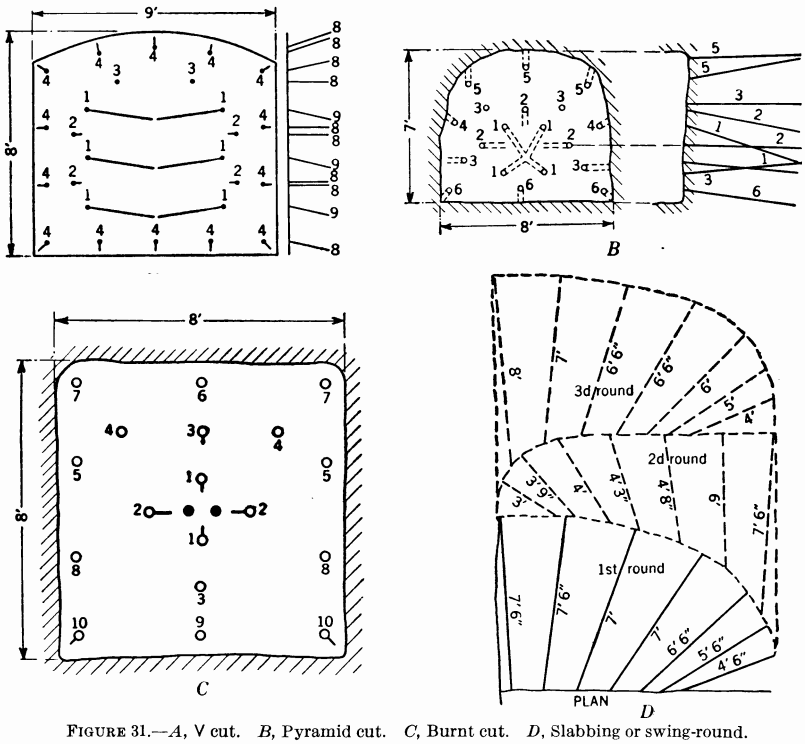
In cut-hole rounds it is sometimes the practice, where it is difficult to break the round, first to load and blast only the cut-holes, return to the face, and, if the cuts do not break, reload them and then load the rest of the holes and blast the entire round. When this is done, it is obvious that good ventilation is required to permit prompt return to the face after the cuts are first blasted.
In any type of round it is essential that the order of firing be such that holes progressively farther from the cut are blasted in succession.
Many adits, particularly if driven in country rock, require no artificial support, or if so, only in certain sections. The back often will stand better without artificial support if it is arched in the center. Some ground will stand unsupported for a time and will then begin to slough. In this instance, timbering can follow some distance behind the face without interruption of the drilling-blasting-mucking cycle.
In worse ground it may be necessary to carry the timbering close to the face and put in a set after each round. Figure 32, A, shows a three- piece set of timber and figure 32, B, an arch set.
Sometimes adits that are in bad ground and are to be in use for a long time are concreted, the concrete being put in after the adit has been completed or in sections, one at a time, as it advances. Figure 32, C, shows a typical concrete lining.
Organization of driving operations is important, especially in three-shift speed work. Where speed is not particularly desired and hand loading is employed on regular shifts, work is generally scheduled so that drilling and blasting are done on one shift and mucking on the next, with a time interval between shifts adequate to allow the smoke to clear. The crew in this case is usually divided into two classifications, miners or machinemen and muckers. In the United States it has been customary for many years to do this type of work on contract; that is, at a straight price per foot of advance. This price usually covers labor only or labor and explosives, but the company guarantees at least minimum prevailing wages. The price may be in the form of a schedule that provides for variations in the rate, depending on the character of the rock, and extra payment for timbering, track laying, and other extras. An alternative is payment according to a bonus system, which provides standard wages for a certain minimum advance per month or per pay period and a graduated increase for footage advanced in excess of the minimum.
Where speed is required, three shifts usually are employed, which may be consecutive or overlapping. In continuous work it is obvious that positive ventilation must be provided to reduce delays after blasting to a minimum. Each operation—drilling, blasting, or shoveling—is completed in the shortest time possible, and each shift usually is composed of a crew capable of performing the work of any part of the cycle under a boss or shift leader. Usually, a bonus system of payment is employed, whereby additional wages are paid for footage that exceeds a fixed minimum per pay period or per month. There are variations in organization of speed work too numerous to be discussed in detail here. When mechanical mucking is in use, there may be a separate crew that comes on after each blast and works split shifts, or the loading machine may be operated by the regular shift crews. Track laying usually is done by the regular crew as part of the contract price, and timbering generally is done by the regular crew when timber must be set after each round is mucked out, or by a special timber crew where timbering follows some distance behind the face.
Cost of Driving an Entrance to an Underground Mine
Costs vary considerably with the size of the heading, drillability of the rock and relative ease with which it breaks, amount and nature of ground support required, speed of driving, equipment employed, labor and supply cost, and other local conditions.
These considerations are obvious for the most part and require no particular discussion except with regard to speed of driving. Up to a certain rate, which varies with conditions, greater speed usually results in savings in cost per foot by reason of reduction of unit over-head or general charges. Beyond this critical rate, the cost per foot will tend to increase. High-speed work is necessarily nicely organized,
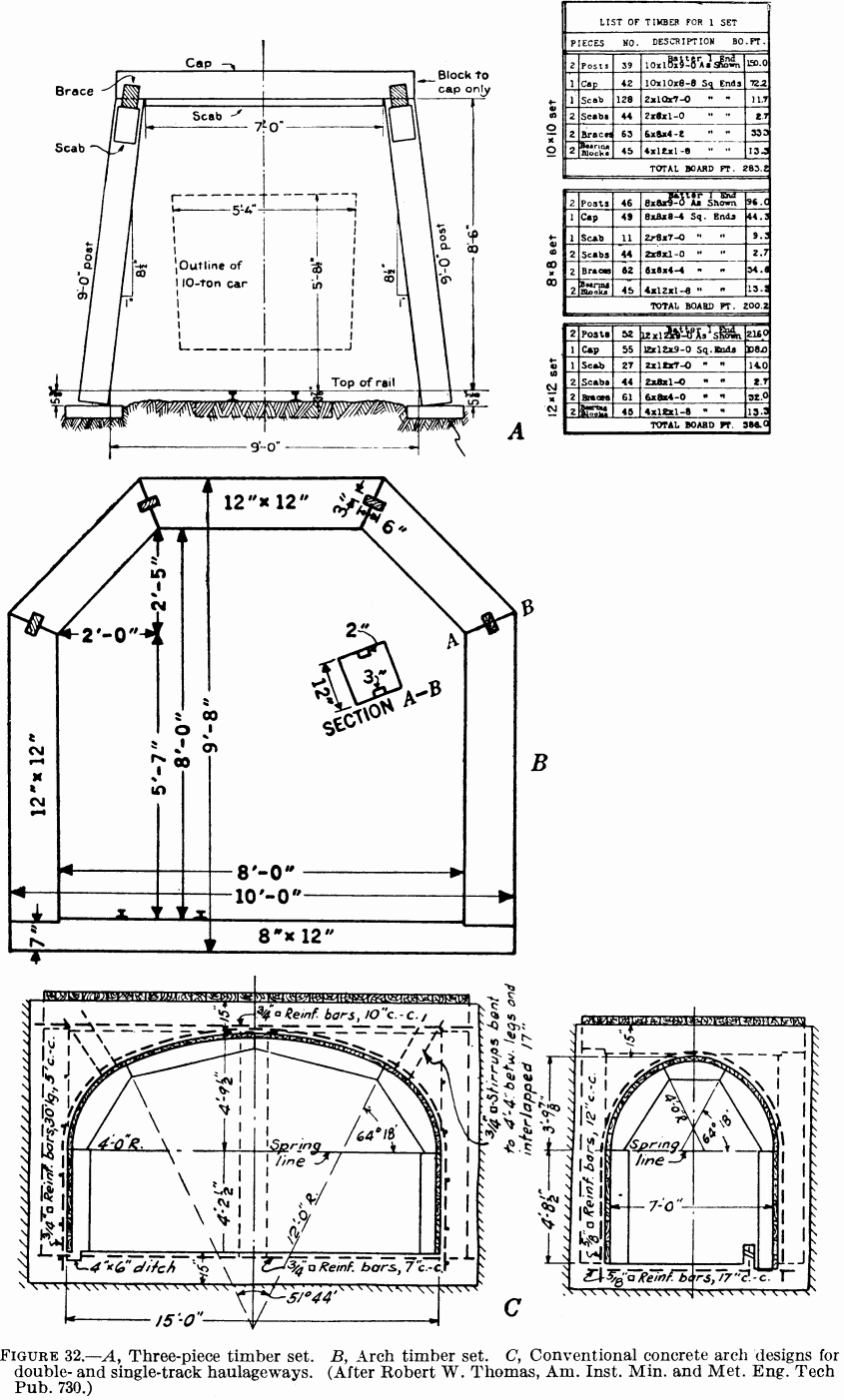
and any disruption in the regular cycle of operations is reflected in increased costs. Thus, for example, where speed is the prime objective, consumption of explosives is likely to be high, due to pulling rounds of more than the most economical length and liberality in amount used per round to insure that the round will break. However, even though costs per foot may be higher, increased speed may actually effect an over-all money saving in the mine operation by advancing the date when ore development and extraction can be begun.
Table 13 gives a few typical examples of costs of driving adits that for the most part are untimbered. Timbering or concreting obviously will add considerably to the cost. At Ray, Ariz. (fig. 32, C), cost of concreting was $22 to $25.24 per cubic yard of concrete placed.
